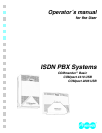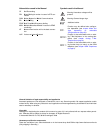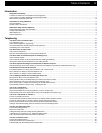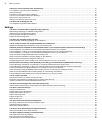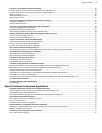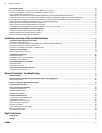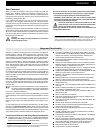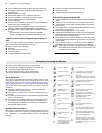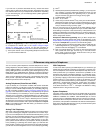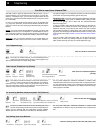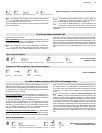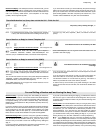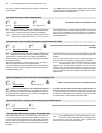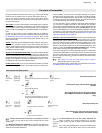
Introduction 9
If you find such a procedure described this way, execute the stated
actions step by step from the left to the right. Symbols that are stated
one under the other are at your disposal as an alternative. Depending
on your functional goal, you can exchange these symbol against the
symbol in the first row.
Example for Programming: You like to set the ringer rhythm “3 x short“
on a telephone for internal calls. In the chapter Configure Ringer
Rhythm for internal Calls on page 39 you find the procedure as
described under Example A and you have to take the following steps:
ቢ Pick up the receiver of the corresponding telephone and wait until
you hear the internal dial tone.
ባ Dial
7.
ቤ Dial the public password (Default factory settings: „2“, but may have
up to 4-digits). If you have entered the password correctly, you will
hear the acknowledgement tone (pulsating tone). If you hear the
busy tone instead, you will have to hang up and try again.
ብ Continue dialling with
97.
ቦ Dial
1 for „3 x short“.
ቧ At the end you confirm with the
# key. Now you hear the acknowl-
edgement tone again as a sign of a proper programming. If you hear
the busy tone instead, you made a mistake (e.g. changed the digits)
and you will have to hang up and try again.
Now you can hang up if you do not like to do further settings. But as
soon as you hear the acknowledgement tone you are able to make addi-
tional settings or enquiries. In this case the entry of the password is not
needed, provided that it is the same password. If you like to make a set-
ting with the secret password or without a password, you will absolutely
have to hang up the receiver.
Example for additional Programming: Now you like to enquire how
many charge units have already been used on this telephone. In the
chapter Enquire Call Charge Sum on page 32 you find the procedure as
described in Example B and you have to do the following steps:
ቢ If you did not hang up after the last setting and if you still hear the
acknowledgement tone, you will have to drop the
7 and the public
password and start with dialling
71 unconditional.
ባ Then you confirm with the
# key. Now you hear some short tones
with a pause after each digit. You hear e.g. for 210 units: 2 short
tones, pause, 1 short tone, pause, 10 short tones. Then you hear
the acknowledgement tone again.
You can connect system telephones and ISDN telephones as well as
analog telephones with pulse dialling or those with dual-tone multifre-
quency dialling (DTMF) to your PBX. Devices with dual-tone multifre-
quency dialling must have a FLASH key (also called signal key R). The
ISDN devices (e.g. ISDN telephones, ISDN PC controllers) should be
certified Euro-ISDN devices in order to guarantee a proper functionality.
There are some differences when using or programming them. Famil-
iarize yourself - especially with ISDN telephones - with the use of your
telephone (see manual of the telephone).
Analog Telephones (Pulse Dial and DTMF)
If you are already in a conversation condition with another subscriber
(internal or external), you will have to press the FLASH key (signal key,
R-Key) in case of a DTMF telephone before you are dialling a digit e.g.
for Call Forwarding (compare chapter Connecting analog Devices on
page 63). In this manual the FLASH key is represented by the symbol
F. The FLASH key is not necessary in case of a pulse dial telephone.
Therefore if you connected a pulse dial telephone to your PBX, ignore
pressing the FLASH key in the descriptions. Besides this the pulse dial
telephones have no
* and no # keys or these keys have no function.
As these keys are necessary for enquiries and settings (programming),
an execution of these functions with a pulse dial telephone is not pos-
sible! If your telephone offers both dial modes, you will have to set it to
DTMF mode by all means.
Analog T-Net-Telephones
With some of the analog DTMF telephones some of the T-Net functions
(e.g. Call Forwarding) are assigned to special menus or function keys.
If you use such a telephone as an internal subscriber telephone, you will
be able to use this comfortable operation also for some functions of the
PBX. These functions are marked with the T-Net-arrow
T. If you
find this advice and you like to use the T-Net functions of your tele-
phone, please read the manual of your telephone. Please pay attention
to the preceding „0“ (exchange line access digit) if you enter the tele-
phone number. Instead of the „announcement of the public exchange“
you will hear the acknowledgement tone for a successful programming.
ISDN Telephones
In order to be able to operate your ISDN telephone, you will have to get
familiar with its functionality. Therefore it is necessary to read the man-
ual of the telephone and to read the ISDN telephone help files of Auer-
swald provided that your telephone is listed there (available on the
Auerswald CD and the Auerswald homepage). It is absolutely neces-
sary to know with which key or with which menu a Query can be started
(e.g. hold key or R-key). This function is required if you see the following
function symbol
F in the manual. In some of the functions you will
have to rely on the menus/function keys of the telephone. „Conference“,
„Alternation“, „Accept/refuse waiting Call“, „Finish Query“ and „finish a
Query on busy target“ belong to these functions. Please pay attention
to the ISDN advice arrow
I. The digits to be dialled for analog
telephones have to be ignored in this case.
System Telephones
The major portion of PBX functions can be handled with all connected
telephones as described in this manual. With the system telephones
COMfortel 1500/2500 and COMfort 1000/1200/2000 plus as well as
smar-tel-i (only for COMmander Basic) the use is much more comforta-
ble because the most important functions can be controlled via menu
(see advice). This operation is described in the manual of the telephone.
Some of the described PBX functions can only be used with the system
telephones as stated in the description.
Example A: Set Ringing Rhythm for internal Calls
Example B: Enquire Call Charge Sum
b7Q97 0#
corresponding
phone
public
password
1xlong
or
1
3 x short
b7Q71#f
corresponding
phone
public
password
digital announcement of total
charges, then acknowledgement tone
Differences using various Telephones



